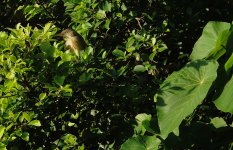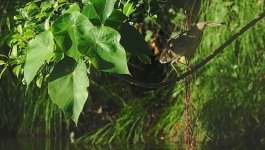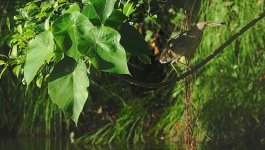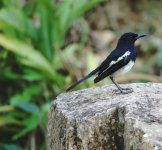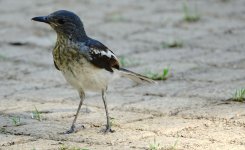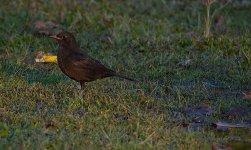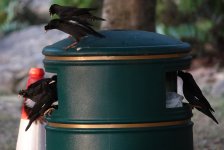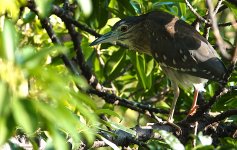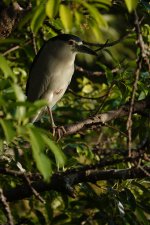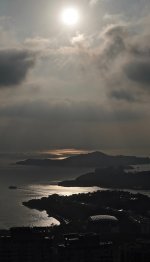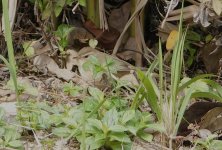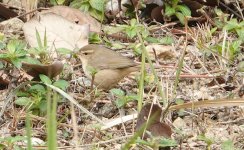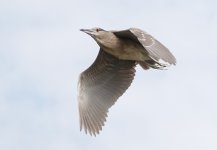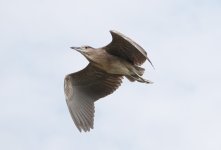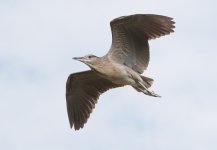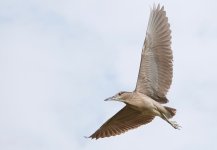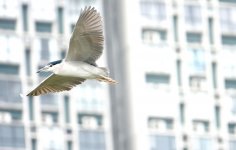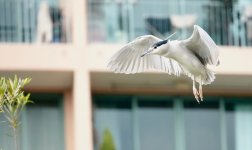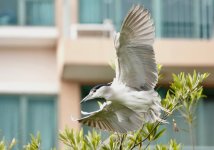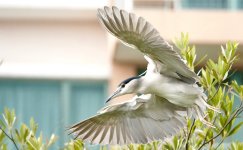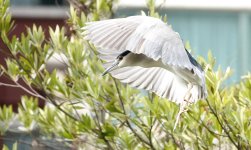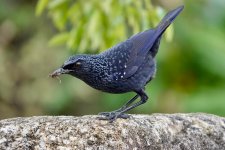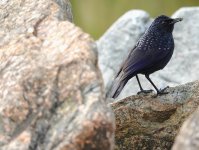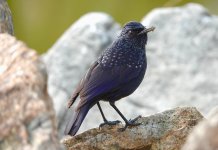-
Welcome to BirdForum, the internet's largest birding community with thousands of members from all over the world. The forums are dedicated to wild birds, birding, binoculars and equipment and all that goes with it.
Please register for an account to take part in the discussions in the forum, post your pictures in the gallery and more.
You are using an out of date browser. It may not display this or other websites correctly.
You should upgrade or use an alternative browser.
You should upgrade or use an alternative browser.
Exploring Lantau (1 Viewer)
- Thread starter MKinHK
- Start date
More options
Who Replied?MKinHK
Mike Kilburn

Summer birding in Discovery Bay
A few weeks ago I was up with the dawn and in my usual hopeful scan I noticed a whole bunch of Black-crowned Night Herons around the edges of the pond in Central Park. Unusually I decided that I would make the best of the cooler early morning to see if I could get some photos and took myself down to the pond. I like park birding; the birds are often highly habituated to people and allow close approach that is rarely possible in other settings. This doesn't apply to every individual and a few nicely-placed adults were less than impressed by my arrival and made themselves scarce so rather than chasing them about I found a spot on some steps that brought me right down to the same level of the water and waited to see what would come to me.
Four or five metres out from here is a vegetated island and a line of rocks almost directly opposite the steps. The palm trees on the top kept me nicely shaded from the rising sun while providing the opportunity to try some backlit photography. This didn't come to much initially , and the results were uninspiring, until ... a newly fledged juvenile bird - complete with a wisp of retained down its crown - slouched slowly round the right hand end of the island and began foraging in the shadows along the shore without paying me the least attention. This allowed me to get some shots I am really pleased with over the next 20 or so minutes.
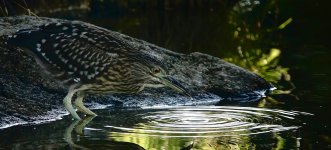
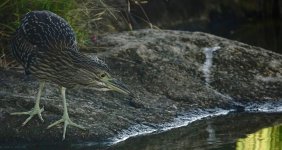
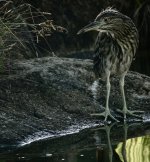
While the youngster was taking a bit of a break I saw a flash out of the corner of my eye and turned just in time to see a much smaller ardeid land in an overhanging banyan about 15 metres away. It helpfully poked its head out and I was able to zoom in and confirm a surprise juvenile Yellow Bittern. Yellow Bittern breeds in Hong Kong, and this could have been a local bird, but I am pretty sure they do not breed here in Discovery Bay, so this was either a post-breeding dispersal or a genuine migrant. better was to come as it stalked through the branches, stopping occasionally when it was completely out of sight until some 15 minutes later it edged into view on a bare elephant ear branch low over the water where it stretched low to grab a Pied Skimmer dragonfly which it displayed nicely for me to grab a couple of shots before slinking back into covers enjoy its breakfast.
More to come ...
Cheers
Mike
A few weeks ago I was up with the dawn and in my usual hopeful scan I noticed a whole bunch of Black-crowned Night Herons around the edges of the pond in Central Park. Unusually I decided that I would make the best of the cooler early morning to see if I could get some photos and took myself down to the pond. I like park birding; the birds are often highly habituated to people and allow close approach that is rarely possible in other settings. This doesn't apply to every individual and a few nicely-placed adults were less than impressed by my arrival and made themselves scarce so rather than chasing them about I found a spot on some steps that brought me right down to the same level of the water and waited to see what would come to me.
Four or five metres out from here is a vegetated island and a line of rocks almost directly opposite the steps. The palm trees on the top kept me nicely shaded from the rising sun while providing the opportunity to try some backlit photography. This didn't come to much initially , and the results were uninspiring, until ... a newly fledged juvenile bird - complete with a wisp of retained down its crown - slouched slowly round the right hand end of the island and began foraging in the shadows along the shore without paying me the least attention. This allowed me to get some shots I am really pleased with over the next 20 or so minutes.



While the youngster was taking a bit of a break I saw a flash out of the corner of my eye and turned just in time to see a much smaller ardeid land in an overhanging banyan about 15 metres away. It helpfully poked its head out and I was able to zoom in and confirm a surprise juvenile Yellow Bittern. Yellow Bittern breeds in Hong Kong, and this could have been a local bird, but I am pretty sure they do not breed here in Discovery Bay, so this was either a post-breeding dispersal or a genuine migrant. better was to come as it stalked through the branches, stopping occasionally when it was completely out of sight until some 15 minutes later it edged into view on a bare elephant ear branch low over the water where it stretched low to grab a Pied Skimmer dragonfly which it displayed nicely for me to grab a couple of shots before slinking back into covers enjoy its breakfast.
More to come ...
Cheers
Mike
Attachments
Last edited:
MKinHK
Mike Kilburn

Mid-July is also prime time for fledgeling passerines, and I enjoyed watching family parties of Oriental Magpie Robins and Crested Bulbuls coming down two the edge of the water nearby. In the end the shots of the Magpie Robins came out pretty well, and a male Crested Bulbul struck the perfect pose on the closest rock.
Just checking the feed also reminded me that I had an amazing run of six different juvenile Asian Koels in just a week around Discovery Bay. Amazingly four of these birds were being fed by two desperately harried Black-collared Starlings in the casuarinas just behind the beach. I was pleased to find the nest, which still held the youngest Koel, two others had mid-length tails, while the fourth bird was almost fully tailed and vigorously pursued the parents, allowing a decent picture. The two other birds were in the banyans close to my block - sitting tight and giving themselves away with their tediously raucous begging calls, which must drive their surrogate parents nuts! Having never seen juvenile Koels before this time last year see post xx above, I'm now on something of a roll...
The only other good bird of the summer has been a rather confiding Striated Heron that has been foraging along the rocks close to the mangroves by Discovery College on a couple of evenings' dog walks and a noisy family of Black Drongos that enlivens just about every walk.
Cheers
Mike
Just checking the feed also reminded me that I had an amazing run of six different juvenile Asian Koels in just a week around Discovery Bay. Amazingly four of these birds were being fed by two desperately harried Black-collared Starlings in the casuarinas just behind the beach. I was pleased to find the nest, which still held the youngest Koel, two others had mid-length tails, while the fourth bird was almost fully tailed and vigorously pursued the parents, allowing a decent picture. The two other birds were in the banyans close to my block - sitting tight and giving themselves away with their tediously raucous begging calls, which must drive their surrogate parents nuts! Having never seen juvenile Koels before this time last year see post xx above, I'm now on something of a roll...
The only other good bird of the summer has been a rather confiding Striated Heron that has been foraging along the rocks close to the mangroves by Discovery College on a couple of evenings' dog walks and a noisy family of Black Drongos that enlivens just about every walk.
Cheers
Mike
MKinHK
Mike Kilburn

There has been a small but steady tickle of migrants through Discovery Bay this autumn. These have included a Cattle Egret hanging out on the grass by the tunnel entrance for a few days this week, the usual arrival of Dusky Warbler, a positive fall of Daurian Redstarts in late November, a couple of Chinese Blackbirds, including a young black-billed male today.
More to come ...
More to come ...
MKinHK
Mike Kilburn

Good birding elsewhere has distracted me from uploading pix from DB that were a first outing for my new Sony RX10iv.
This Chinese Blackbird was foraging on some damp ground just as the sun emerged above the horizon, lighting up the fine details of the belly plumage and centred the catchlight in its eye.
Up to 40 Black-crowned Night Herons roost in the Park. I have not yet made a full count, but I suspect there are more this year. This young bird was preparing to roost in a pondside banyan.
My previous best shots were with the light behind the bird, so this one, again with the catchlight on the eye, offered a different shot.
Cheers
Mike
This Chinese Blackbird was foraging on some damp ground just as the sun emerged above the horizon, lighting up the fine details of the belly plumage and centred the catchlight in its eye.
Up to 40 Black-crowned Night Herons roost in the Park. I have not yet made a full count, but I suspect there are more this year. This young bird was preparing to roost in a pondside banyan.
My previous best shots were with the light behind the bird, so this one, again with the catchlight on the eye, offered a different shot.
Cheers
Mike
Last edited:
MKinHK
Mike Kilburn

A productive dart up the hillside behind my block produced a fine range of woodland/shrubland species that included 4 Siberian Rubythroats, 2 Rufous-Tailed Robins, 2 Asian Stubtails, a female Fork-tailed Sunbird, 3 Black-faced Buntings and a fine male Daurian Redstart. As I got to the flatter ground three Sooty-headed Bulbuls bounced into a taller shrub. Other bits and pieces included a couple of Common Tailorbirds, two Cinereous Tits, Yellow-bellied Prinia, two Large-billed Crows and both Crested and Chinese Bulbuls.
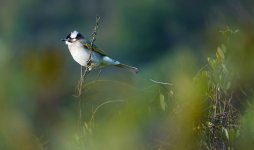
A female Eurasian Kestrel went over while I was on top of the ridge and an Eastern Buzzard hanging absolutely motionless on the wind as the mid-morning commute of Crested Mynas bounced onto the top of the buildings before coming up into the scrubland to feed.
Cheers
Mike

A female Eurasian Kestrel went over while I was on top of the ridge and an Eastern Buzzard hanging absolutely motionless on the wind as the mid-morning commute of Crested Mynas bounced onto the top of the buildings before coming up into the scrubland to feed.
Cheers
Mike
MKinHK
Mike Kilburn

A Saturday morning dog walk in Central Park turned up patch gold when a warbler flicking about in a tiny hedge went "tic" instead of "tak". As I followed, it continued to call and gave naked eye views as it foraged in the flower beds above the waterfalls, but without bins or a camera it could only go down as a "suspected" until the next morning when I was able to grab some pix and again hear it call, thereby becoming a confirmed Yellow-streaked Warbler! With around 20 records in Hong Kong, this is one of my top Discovery Bay finds, and a great addition to my Hong Kong self-found list, which now stands at 414 .
Yellow-streaked Warbler is one of the hardest birds in Hong Kong to identify. It is very similar to the abundant Dusky Warbler and much scarcer Radde's Warbler, but has a distinctively slender and pointy tipped bill than Radde's, which is a rougher-formed and more colour-toned version of the darker and longer-tailed Dusky Warbler. The bunting-like "tic" call, and presumably the song at the right time of year, is by far the best way to identify it and I have listened to hundreds if not thousands of Duskies and wondering if that call was a "tic" or a "tak". As with many such cases there's no doubt when you hear the real thing! It was not that easy to connect with, but I did eventually manage some pix and a video that allowed the key features to be seen.
Here's all three species. Top left is the Dusky Warbler was taken the same day, but hidden deep in a bush so the light does not allow for the best comparison, while the Radde's Warbler (top right) was on my Magic Roundabout patch at airport in November 2015. The Yellow-streaked Warbler is shown in the lower 3 pix). It clearly lacks the greyish brown colour tones of the Dusky Warbler, which always looked longer tailed and showed a much more distinctive eyestripe and a hint of a lateral crown stripe above the supercilium. The Radde's Warbler has a broad-based stubby bill, a broader dark eyestripe that is more distinctive behind the eye, a ,longer tapering supercilium with a hint of rufous in front of the eye, mealy cheeks, and a hint of a wing panel. In contrast the Yellow-streaked Warbler is much more uniform than the Radde's on the face and wings and has a bill that is in this individual reassuringly fine and pointed - the final pic shows this really well. The supercilium is rather broad and square-ended, and lacked any hint of rufous tones in front of the eye. If anything it was more willing to show itself than the Dusky Warbler that was always in cover.
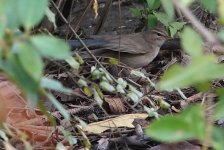
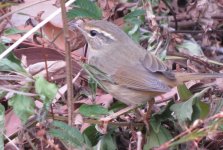
Other birds that contributed to a wonderful day were a female Daurian Redstart in the veggie patch, a Black-winged Cuckooshrike that had lost a substantial portion of the feathers on its right wing in one of camphor trees on the main lawn, and great views of a range of species munching on the fan palm fruit that included Chinese and Crested Bulbuls, Crested Mynas, Black-collared Starlings, Asian Koel Tree Sparrows and Spotted Doves. I also enjoyed the Crested Bulbuls and Crested Mynas coming in to bathe at the spot I spent most of my time looking for the Yellow-streaked Warbler, which also hosted a couple of Oriental Magpie Robins and a wonderful huddle of Scaly-breasted Munias clambering on top each other to get to the middle and stay warmest. While I've seen them huddling in bushes multiple times I've never seen this on the ground before.
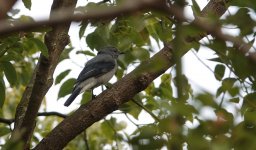
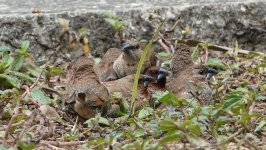
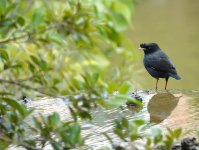
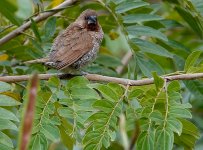
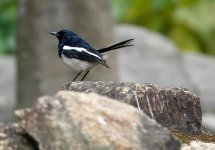
I'll post separately on some pix of the Black-crowned Night Heron's which provided a terrific opportunity to learn a little more about the birds in flight capability of the RX10iv
As an extra bonus here's a video of the Yellow-streaked Warbler inaction, but not ticking...
Cheers
Mike
Yellow-streaked Warbler is one of the hardest birds in Hong Kong to identify. It is very similar to the abundant Dusky Warbler and much scarcer Radde's Warbler, but has a distinctively slender and pointy tipped bill than Radde's, which is a rougher-formed and more colour-toned version of the darker and longer-tailed Dusky Warbler. The bunting-like "tic" call, and presumably the song at the right time of year, is by far the best way to identify it and I have listened to hundreds if not thousands of Duskies and wondering if that call was a "tic" or a "tak". As with many such cases there's no doubt when you hear the real thing! It was not that easy to connect with, but I did eventually manage some pix and a video that allowed the key features to be seen.
Here's all three species. Top left is the Dusky Warbler was taken the same day, but hidden deep in a bush so the light does not allow for the best comparison, while the Radde's Warbler (top right) was on my Magic Roundabout patch at airport in November 2015. The Yellow-streaked Warbler is shown in the lower 3 pix). It clearly lacks the greyish brown colour tones of the Dusky Warbler, which always looked longer tailed and showed a much more distinctive eyestripe and a hint of a lateral crown stripe above the supercilium. The Radde's Warbler has a broad-based stubby bill, a broader dark eyestripe that is more distinctive behind the eye, a ,longer tapering supercilium with a hint of rufous in front of the eye, mealy cheeks, and a hint of a wing panel. In contrast the Yellow-streaked Warbler is much more uniform than the Radde's on the face and wings and has a bill that is in this individual reassuringly fine and pointed - the final pic shows this really well. The supercilium is rather broad and square-ended, and lacked any hint of rufous tones in front of the eye. If anything it was more willing to show itself than the Dusky Warbler that was always in cover.


Other birds that contributed to a wonderful day were a female Daurian Redstart in the veggie patch, a Black-winged Cuckooshrike that had lost a substantial portion of the feathers on its right wing in one of camphor trees on the main lawn, and great views of a range of species munching on the fan palm fruit that included Chinese and Crested Bulbuls, Crested Mynas, Black-collared Starlings, Asian Koel Tree Sparrows and Spotted Doves. I also enjoyed the Crested Bulbuls and Crested Mynas coming in to bathe at the spot I spent most of my time looking for the Yellow-streaked Warbler, which also hosted a couple of Oriental Magpie Robins and a wonderful huddle of Scaly-breasted Munias clambering on top each other to get to the middle and stay warmest. While I've seen them huddling in bushes multiple times I've never seen this on the ground before.





I'll post separately on some pix of the Black-crowned Night Heron's which provided a terrific opportunity to learn a little more about the birds in flight capability of the RX10iv
As an extra bonus here's a video of the Yellow-streaked Warbler inaction, but not ticking...
Cheers
Mike
Last edited:
Jeff Hopkins
Just another...observer

Great find, Mike!
MKinHK
Mike Kilburn

Many thanks Jeff!
Continuing my blossoming love affair with the Sony RX10iv here's a few pix of Black-crowned Night Herons in flight that show the BiF capabilities of the camera with the settings suggested in DP Review. I love that I just have to walk five minutes downhill to have access to this flock of around 50 birds which allow wonderfully close approach and every so often get helpfully flushed by other visitors to the park.
Cheers
Mike
Continuing my blossoming love affair with the Sony RX10iv here's a few pix of Black-crowned Night Herons in flight that show the BiF capabilities of the camera with the settings suggested in DP Review. I love that I just have to walk five minutes downhill to have access to this flock of around 50 birds which allow wonderfully close approach and every so often get helpfully flushed by other visitors to the park.
Cheers
Mike
Last edited:
MKinHK
Mike Kilburn

Blue Whistling Thrush
Another set of portraits of a common DB resident; this time a young Blue Whistling Thrush (as can be told by the biggest white spots on the coverts) that was foraging on the rocks on the edge the pond in Central Park. The first shot it saw me and snapped into its danger pose, and thereafter, having decided I was harmless it relaxed and continued to forage very close-by.
Cheers
Mike
Another set of portraits of a common DB resident; this time a young Blue Whistling Thrush (as can be told by the biggest white spots on the coverts) that was foraging on the rocks on the edge the pond in Central Park. The first shot it saw me and snapped into its danger pose, and thereafter, having decided I was harmless it relaxed and continued to forage very close-by.
Cheers
Mike
MKinHK
Mike Kilburn

The good thing about finding other birders in DB is that you hear about more birds. Will - a kayaking birder mate found these three terrific Pied Avocets bizarrely sitting on the sea near the ferry pier on Sunday.
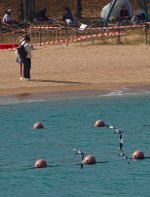
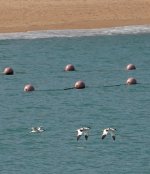
In nice contrast an hour in the scrubland on the slope behind my building delivered a bunch of heard and not seen birds including a singing Siberian Rubythroat, Asian Stubtail, and a couple of Hwameis. While walking th dogs a little earlier I did have a nice male Grey-backed Thush under the big banyan bt the tunnel and a Chinese Blackbird flying around excited about something or other.
Cheers
Mike


In nice contrast an hour in the scrubland on the slope behind my building delivered a bunch of heard and not seen birds including a singing Siberian Rubythroat, Asian Stubtail, and a couple of Hwameis. While walking th dogs a little earlier I did have a nice male Grey-backed Thush under the big banyan bt the tunnel and a Chinese Blackbird flying around excited about something or other.
Cheers
Mike
Last edited:
Users who are viewing this thread
Total: 2 (members: 0, guests: 2)




